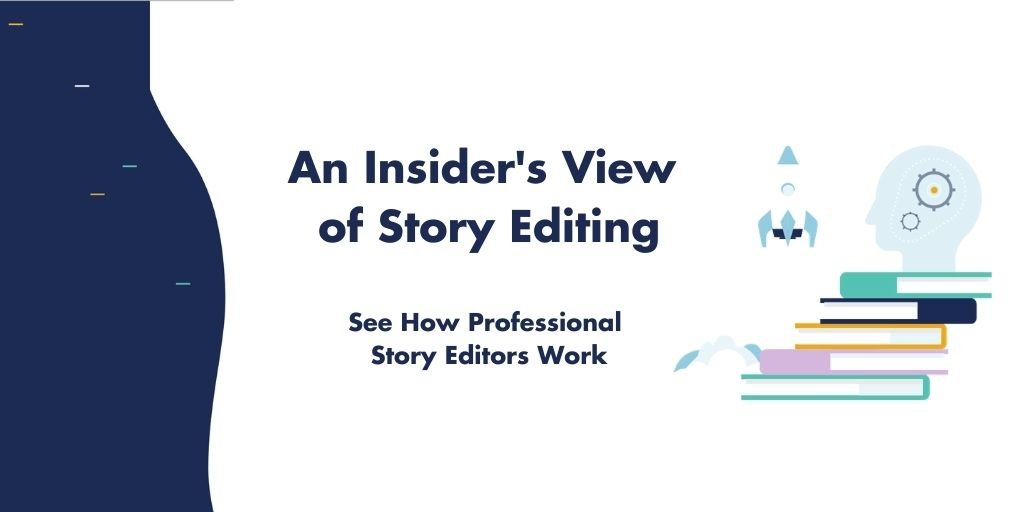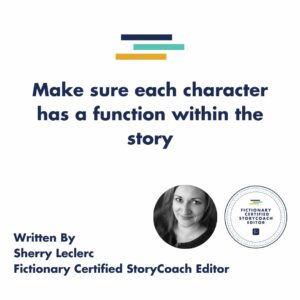
Creating a killer cast of characters for your novel can make a big impact on your story’s success.
Why?
Because, as Kristina Stanley says in her article Make the Most of Your Cast of Characters:
“These characters act and react. They create emotion. They show motivation. Without any of this, you don’t have a story.”
It isn’t enough to fully develop a strong, interesting protagonist and antagonist and ignore the rest.
So how, exactly, do we create a killer cast of characters?
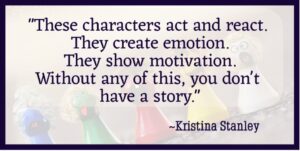
7 Tips for Writing a Killer Cast
Plan your cast of characters before you start to write
If you’re a discovery writer, a.k.a. a pantser, you’re probably groaning at this piece of advice.
However, characters are the driving force of your story, so having a handle on at least your main characters right from the start will be a definite advantage. Remember, starting with a basic cast of characters doesn’t mean you can’t:
- Add,
- Delete,
- Merge, or;
- Change characters as you write
I can be considered a ‘plantser’—I do plan and outline, but not extensively.
When it comes to my cast of characters, I start with those I anticipate needing, but I fully expect that more characters will pop in as I write. I might need someone for a specific purpose that I hadn’t anticipated when planning, for example.
When this happens, I just add a character sheet with a basic description of the character and their function(s) in the story. If it’s a minor character that will be seen only once or twice, that may be all I come up with. For characters of more importance, I’ll create some backstory.
Make sure there is a purpose behind each character
When you plan your cast of characters, make sure each character has a function within the story.
- Why is that character there?
- Are they necessary for the plot or a sub-plot?
- Are they the representation of a theme?
- Do they serve as a foil for your protagonist?
Of course, the protagonist’s motivations, goals, and actions will be the most important in moving the plot forward.
However, as stated in the article Creating a Supporting Cast of Characters on the All Write—Fiction Advice blog:
“Any supporting cast of characters has their own little part to play in the story.”
If they don’t, then they shouldn’t be in the story. Also, if you find you have multiple characters with the same purpose, ask yourself if they can be merged.
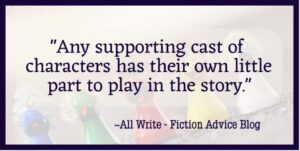
Following this tip can also help ensure you have just the right number of characters for your story.
Show, don’t tell, who your character is
‘Show, don’t tell’ is a piece of advice that any author who’s been writing a while has likely heard.
This doesn’t just apply to the actions and descriptions in the story—it’s true for characters as well. Show who they are through their:
- Inner thoughts,
- Dialogue,
- Gestures, and;
- actions.
For example, in The Hunger Games, Suzanne Collins doesn’t come right out and say,
“Katniss is a survivor whose motivation is love for her family and whose goal is to keep her family safe.”
Instead, Collins shows Katniss illegally sneaking through the district fence and hunting for food for her family. She shows Katniss immediately jumping in to volunteer as tribute when her sister’s name is chosen.

Create a clear voice for each character
This one is closely related to the previous point because one way you can show who your character is, is through their voice.
In a recent Fictionary webinar, The Dialogue Doctor, Jeff Elkins, pointed out that a character’s voice is not their background and it’s not their personality, though these things do contribute.
It is how a character expresses themselves outwardly, with words and with body language.
For example, a shy character won’t jump into or start a lot of conversations. A charming character will smile a lot and will likely ask questions to draw others out.
Aside from telling us about characters’ personalities, using a clear voice for each character can tell readers about characters’:
- Social rank,
- Education level,
- Where they are from,
- And so on
It can also help ensure that readers know who is speaking at any time.
Know your characters
When I’m planning a novel, I create a detailed and in-depth backstory for my:
- Protagonist,
- Antagonist, and;
- Any major players.
For characters that will be seen repeatedly but are not as important as the major characters, I will create just enough explain how they:
- Speak,
- Feel,
- Act, and;
- React
So I can be sure I’m being consistent anytime they show up in the story.
For characters that show up once or twice, or even just a handful of times, you don’t need an in-depth backstory.
As Sacha Black says in her book, 8 Steps to Side Characters:
“Minor characters can be two dimensional . . .These guys aren’t in the story or affecting the story enough to warrant anything more dimensional.” (p. 31)
Use physical description in a way that feels natural and don’t overdo it
As Kristina Stanley points out in her article, Connect Readers with Characters Using Description, physical description is actually the least important information to give. She states:
“The reader will be more interested in what a character does than what they look like.”
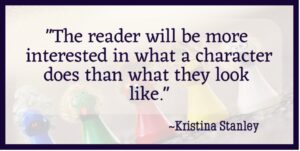
Yes, use enough physical description to enable your readers to form a mental image, but don’t give minute, down-to-the-smallest-detail descriptions.
Readers can use their own imaginations to fill in the details.
Also, in every scene, the readers experience the story through a point-of-view character’s perspective.
Therefore, if you’re describing a character in a scene where they’re also the POV character, remember that, in real life, most of us don’t go around describing our own physical appearances when we walk into a room.
It would not seem natural for a character to describe themselves unless, for example, they are checking themselves out in the mirror before heading to the ball.
You can make physical descriptions feel more natural if they’re given for a reason that makes sense, in a way that would make sense.
For example, you can have a different character or characters comment on how that person looks through dialogue:
“You’re five-foot nothing and your arms look like limp noodles. There’s no way you’re gonna lift that.”
Think of the expectations for your genre
Readers expect certain things in certain genres, and not giving them what they expect can lead to feelings of dissatisfaction. Not only is this true of tropes, but it’s also true for character types/archetypes.
Romance novels, for example, need a:
- Hero or heroine,
- A love interest,
- Helpers, and;
- Hinderers.
Mystery novels require:
- A sleuth,
- A sidekick,
- A villain, and;
- A red herring (an innocent character the sleuth mistakenly pursues early on).
An epic fantasy will have:
- A hero,
- A villain,
- A mentor,
- A love interest, and;
- Henchmen.
You can, of course, add other characters as needed, but make sure you include the ones that are expected in your genre.
References/Further Reading
http://allwritefictionadvice.blogspot.com/2016/03/creating-supporting-cast-of-characters.html
Black, S. 8 Steps to Side Characters: How to Craft Supporting Roles with Intention, Purpose, and Power. Atlas Black Publishing, 2021.
https://fictionary.co/journal/connect-readers-with-characters-using-description/
https://fictionary.co/journal/characters-novel-structure-and-revising-your-first-draft/
https://fictionary.co/journal/make-the-most-of-your-cast-of-characters/
https://www.helpingwritersbecomeauthors.com/large-casts-of-characters/
Article Written by Sherry Leclerc

Sherry Leclerc is a Fictionary Certified StoryCoach editor, Fictionary content creator, Writer’s Digest certified copy editor, and independent author. She is a member of Editor’s Canada, the Canadian Authors Association (CAA), and The Alliance of Independent Authors (ALLi).
Sherry holds a B.A. in English Language and Literature and a B.Ed. She is the sole proprietor of Ternias Publishing, through which she offers various editorial services. She also has a YouTube channel where she has a vlog about writing and editing, titled The Mythic Quill. You can find it on Youtube .
Sherry currently lives in Sydney, Nova Scotia, Canada. You can contact her at [email protected] or [email protected]
When do you ever get to see what a story editor delivers to a client if the client is not you?
If you’re thinking of becoming a story editor, this course is for you. Our course gives you an insider’s view of what happens in a story edit. This is similar to a structural or substantive edit for fiction.
Before you hire an editor or edit your own story, it’s important to understand what a story edit is.
Thirteen professional editors edited the same novel.
Each editor worked separately in Fictionary StoryCoach.
This course evaluates their edits and shows you what worked and what didn’t. We’ll show you two scenes before editing and after revisions based on the editors’ suggestions. We even compare the editors’ summary letters and per scene notes.
For writers looking to hire a professional story editor, this course shows you what you should receive from a story editor. It will also show you how an editor might look at your story.’
Sign up now for great value.
On sale for $39 USD. Use Coupon INSIDERSVIEW
Regular Price: $99.


